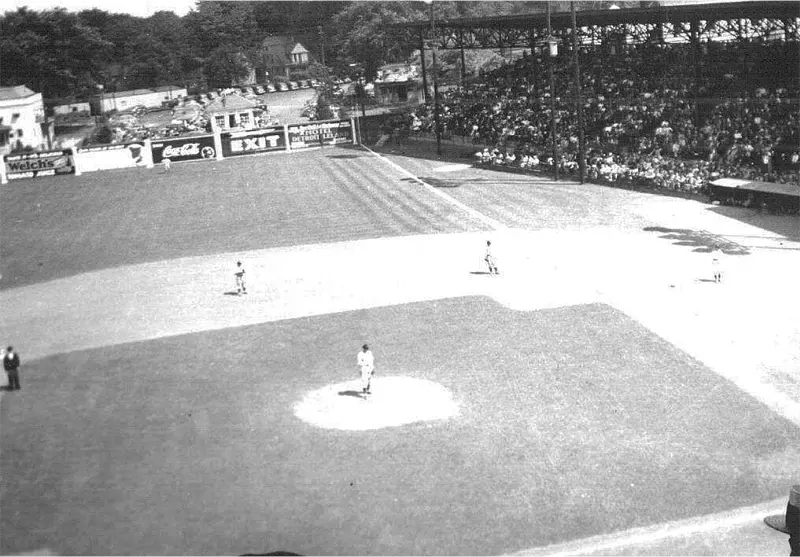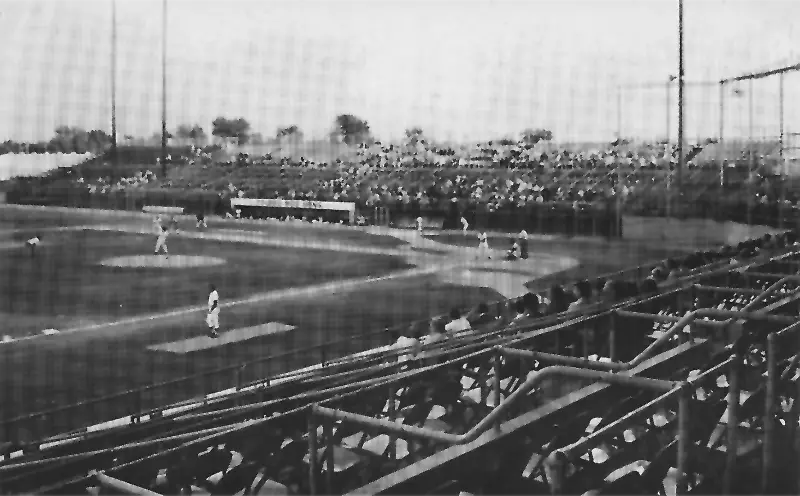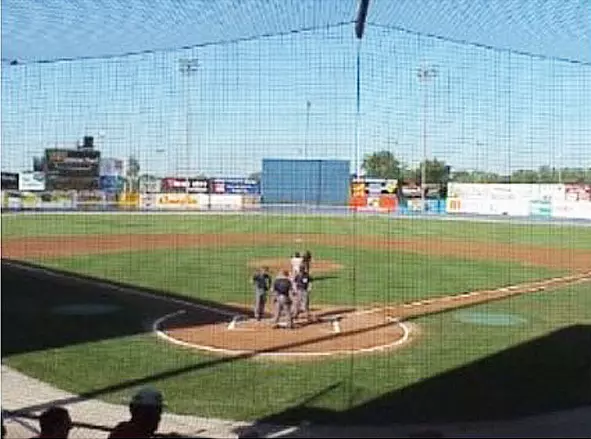Major League Affiliates
<
|
Years |
League |
Affiliate |
|
1932 |
American Association |
Cleveland Indians |
|
1936-1939 |
American Association |
Detroit Tigers |
|
1940-1948 |
American Association |
St. Louis Browns |
|
1949-1951 |
American Association |
Detroit Tigers |
|
1953-1955 |
American Association |
Milwaukee Braves |
|
1965-1966 |
International |
New York Yankees |
|
1967-1973 |
International |
Detroit Tigers |
|
1974-1975 |
International |
Philadelphia Phillies |
|
1976-1977 |
International |
Cleveland Indians |
|
1978-1986 |
International |
Minnesota Twins |
|
1987-Present |
International |
Detroit Tigers |
Bibliography
Toledo Mud Hens
Benson, Michael. Ballparks of North America: A Comprehensive Historical Reference to Baseball Grounds, Yards, and Stadiums, 1845 to Present. McFarland Publishing. Jefferson, NC. 1989.
Blahnik, Judith and Phillip S. Schulz. Mud Hens and Mavericks. Viking Studio Books. New York. 1995.
Husman, John. Baseball in Toledo. Arcadia Publishing. Charleston, SC. 2003.
Longert, Scott. Addie Joss: King of the Pitchers. Society of American Baseball Research. Cleveland, OH. 1998.
O'Brien, John, Jerry De Bruin and John Husman. Mud Hen Memories. Perrysburg, OH. 2001.
Roger Bresnahan/Mud Hens Chapter of the Society of American Baseball Research. Blue Stockings to Mud Hens: A History of Professional Baseball in Toledo, Ohio. Roger Bresnahan/Mud Hens Chapter of the Society of American Baseball Research. Toledo, OH. 1998.
Archival material, including photographs, used courtesy of the Toledo Lucas County Public Library, Images in Time.
Negro Leagues in Toledo
Heaphy, Leslie A. The Negro Leagues: 1869-1960. McFarland and Company. Jefferson, NC. 2003.
Ribowsky, Mark. A Complete History of the Negro Leagues: 1884-1955. Birch Lane Press. New York. 1995.
Archival material, including photographs, used courtesy of the Negro Leagues e-Museum.
Essays
Baade, Robert A. and Allen R. Sanderson. "Cities Under Seige: How the Changing Financial Structure of Professional Sports is Putting Cities at Risk and What to Do About It," in Advances in the Economics of Sports, vol. 2. JAI Press. Greenwich, CT. 1997.
---- "Minor League Teams and Communities," in Sports, Jobs, and Taxes: The Economic Impact of Sports Teams and Stadiums. Donnelly and Sons. Harrisonburg, VA. 1997.
Johnson, Arthur T. Minor League Baseball and Local Economic Development. University of Illinois Press. Champaign, IL. 1993.
Kraus, Rebecca S. Minor League Baseball: Community Building Through Hometown Sports. Haworth Press. New York. 2003.
Quirk, James P. and Rodney Fort. Hard Ball: The Abuse of Power in Pro Team Sports. Princeton University Press. Princeton, NJ. 1999.
Rosentraub, Mark S. "Stadiums and Urban Space," in Sports, Jobs, and Taxes: The Economic Impact of Sports Teams and Stadiums. Donnelly and Sons. Harrisonburg, VA. 1997.
Web resources
Baseball Reference.com, accessed online at http://www.baseball-reference.com/.
ESPN. The Best of the Minor Leagues. http://sports.espn.go.com/travel/news/story?id=2909747
Negro Leagues e-Museum. http://www.coe.ksu.edu/nlbemuseum/history/teams.html
Toledo Lucas County Public Library
Glossary
Affiliation System - Each minor league team negotiates a contract with a "parent" club in the Major Leagues, i.e. the Mud Hens with their parent club the Detroit Tigers. These contracts usually run from one to five years. Since the players are technically the property of the parent club, all the minor league team pays for is the day- to-day operations and stadium costs for the team, with contracts being paid by the parent club.
The first "minor league" was the Northwest League of 1883-1884. The Toledo franchise was the champion of the charter season of the league. Toledo has had various affiliations throughout its nearly 120 years of baseball, including the Browns; Indians; Tigers; Twins; and Phillies. The Tigers have been a parent club on more than one occasion.
American Association - The American Association (minor league; not the precursor to the American League) would prove to be far more stable than any of the past leagues that Toledo participated in. With teams in cities such as Columbus, Louisville, Indianapolis, Kansas City, Milwaukee, and Minneapolis-St. Paul, the league would prove to be far stronger financially than any of the previous minor leagues. The American Association still exists today.
Blue Laws - Laws in the city of Toledo which prevented most businesses from operating on Sundays. The Blue Laws had been in effect prior to the founding of the Toledo franchise, but were not enforced until 1895. This would change with an affidavit filed by Ewing Street residents against the city for the running of the trolley to transport fans to baseball games. Then-owner Denny Long was able to subvert the law by playing Sunday games outside the city limits, but eventually was unable to continue to fight them. In 1896, the team left Northwest Ohio, relocated to Terre Haute, IN and was renamed the Hottentots. Ironically, trolley cars played a major role in Long choosing Terre Haute: he was promised 2 cents for every person that attended a Hottentots baseball game by a Terre Haute trolley car company.
Farm Team - Branch Rickey, the baseball innovator who de-segregated baseball by signing Jackie Robinson, also invented the minor league farm system. Rickey, then with the St. Louis Cardinals, devised a system that would allow him to train players in the minor leagues and then bring them up to help the parent club when needed. This was not looked upon fondly by Commissioner Kennesaw " Mountain " Landis, who fought the system on the grounds that it would destroy the minor leagues. Rickey would eventually prevail and the system is now in place, with multiple classes for every Major League baseball franchise.
Governors Cup - Awarded to the champion of the International League. The cup was originally devised when the Governors of Maryland, New Jersey, and New York along with the Lieutenant Governors of the Provinces of Quebec and Ontario, sponsored a trophy for the winner of the International League. A trophy has been awarded every year since 1933. The first version of the trophy, which was designed by Supervisor of International League Umpires W.B. Carruth and made of pure silver, is currently on display at the Major League Hall of Fame in Cooperstown, NY. The current trophy (won by the Mud Hens in 2005 and 2006) resides at the home of the winner.
International League - Minor League system that was initially created in 1884 out of a merger of three other minor leagues systems. The league has operated teams in Canada, the eastern seaboard of the US, the Midwest, and even in Havana, Cuba prior to Fidel Castro's rule.
Toledo Stadiums, 1883-Present
|
Seasons |
Teams |
Capacity |
Location |
|
|
Presque Island Park |
1883 |
Blue Stockings, Maumees |
N/A |
Now C&O Coal Docks |
|
League Park |
1884 |
Blue Stockings |
N/A |
13th and Monroe St. |
|
Tri-State Fairgrounds |
1884 |
Blue Stockings (Sunday games) |
N/A |
Oakwood and Upton St. |
|
Speranza Park |
1890 |
Maumees |
N/A |
Cherry and Frederick St. |
|
Bay View Park |
1891-1901 |
Swamp Angels, Mud Hens |
N/A |
3900 N. Summit St. (now a senior citizen golf course) |
|
Armory Park |
1901-1909 |
Detroit Tigers, Mud Hens |
N/A |
Speilbush Ave. |
|
Noah H. Swayne Field |
1909-1956 |
Iron Men, Mud Hens, Soumichers, Negro League Tigers, Crawfords |
14,800 |
Monroe and Detroit St. |
|
Ned Skeldon Stadium (formerly Lucas County Stadium) |
1965-2002 |
Mud Hens |
13,695 (1966) |
2901 Key St. Maumee, OH |
|
Fifth Third Field |
2002-Present |
Mud Hens |
10,000 (2002) |
406 Washington St., Toledo, OH. |
Swayne Field, (1909-1956)
![Swayne Field, Toledo, Ohio [approximately 1955] Swayne Field, Toledo, Ohio [approximately 1955]](https://mail.toledosattic.org/images/jch-optimize/ng/images_exhibits_Baseball_swaynefield-ca1955.webp) Swayne Field, Toledo, Ohio [approximately 1955]
Swayne Field, Toledo, Ohio [approximately 1955] A photo of a game at Swayne Field, original home of the Toledo Mud HensSwayne Field, sometimes known as Mud Hen Park, was built in 1909 on land donated by Toledo businessman and baseball fan Noah H. Swayne. The financier of the project, then-owner William R. Armour, wanted the stadium to be the most modern in all of the minor leagues and did not spare a penny in trying to achieve this goal.
A photo of a game at Swayne Field, original home of the Toledo Mud HensSwayne Field, sometimes known as Mud Hen Park, was built in 1909 on land donated by Toledo businessman and baseball fan Noah H. Swayne. The financier of the project, then-owner William R. Armour, wanted the stadium to be the most modern in all of the minor leagues and did not spare a penny in trying to achieve this goal.
The first team to play at Swayne Field was the 1909-1913 Toledo Mud Hens. When owner Charles Somers moved the team to Cleveland to block the expansion of the Federal League, a lower level Michigan minor league team began playing at Swayne Field. Due to poor attendance for this lower brand of baseball, the stadium sat empty for the 1915 season.
Swayne Field was also home to the Negro League teams of Detroit and Toledo. From 1923 to 1955, the Tigers and the Crawfords both played there. The stadium was also used for high school baseball games and other local events.
The first game played at Swayne Field was on July 3, 1909. Thestadium would be the home of Casey Stengel and the 1927 Junior World Series Champions, but few other winning seasons. In 1933, the stadium added lights to allow for nighttime baseball.
 Swayne Field, Toledo's New Ball Park
Swayne Field, Toledo's New Ball Park
The field was rather large by today's standards, with the center field fence sitting 472 feet from home plate. Only one player, Sam Jethroe, was credited with hitting a ball out to dead center field. Behind the center field was the coal pile for the Red Man Tobacco plant. On a day when the wind was blowing in, the field was engulfed in the smell of unprocessed tobacco.
In 1955, with the Mud Hens wooed away from the city once again, in the name of "progress," Swayne Field was torn down and replaced with a shopping mall. Today, there are no reminders of what used to be the most modern and beloved minor league stadium.
Ned Skeldon Stadium (1965-2002)
 Lucas County Recreation CenterAfter a decade without baseball, Toledo was finally given another franchise in 1965 when the struggling International League team from Richmond, Va. relocated to the city. The Mud Hens were set to begin play in 1965 at the newly renovated Lucas County Stadium, which was located on the grounds of the Lucas County Recreation Center.
Lucas County Recreation CenterAfter a decade without baseball, Toledo was finally given another franchise in 1965 when the struggling International League team from Richmond, Va. relocated to the city. The Mud Hens were set to begin play in 1965 at the newly renovated Lucas County Stadium, which was located on the grounds of the Lucas County Recreation Center.
Lucas County Stadium was built using the grandstands from a horse track at the Lucas County Fairgrounds. These grandstands made up the seating behind the home plate dugout. The plan to bring baseball back to Northwest Ohio, as well as to build the stadium at the Lucas County Fairgrounds in Maumee, was devised by Ned Skeldon (then county commissioner) and a non-profit group created to bring baseball back to the Toledo area.
The stadium was known for its "fair" type atmosphere, as well as the long exposed walk of the players from the dugout to their respective locker rooms. This area proved to be an excellent place for fans to collect autographs from their favorite players.
In 1988, the name of the stadium was changed to Ned Skeldon Stadium, to honor the man who helped bring baseball back to Northwest Ohio.
 Ned Skeldon StadiumBy this time, what were once quirky charms of the stadium had grown into annoyances, as the stadium that was once known as one of the best in the minor leagues was now being compared to a high school facility. The Mud Hens played their final game in Ned Skeldon Stadium in 2002, officially moving the team back to Toledo and a new downtown location.
Ned Skeldon StadiumBy this time, what were once quirky charms of the stadium had grown into annoyances, as the stadium that was once known as one of the best in the minor leagues was now being compared to a high school facility. The Mud Hens played their final game in Ned Skeldon Stadium in 2002, officially moving the team back to Toledo and a new downtown location.
Today, Ned Skeldon Stadium is used for various activities, such as local baseball games and adult leagues.
